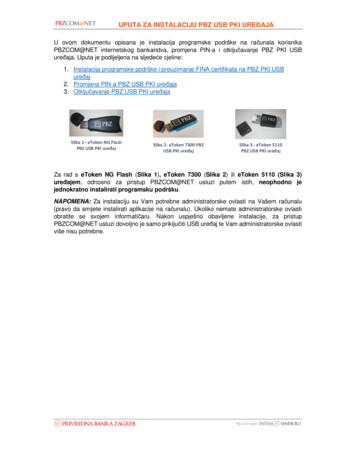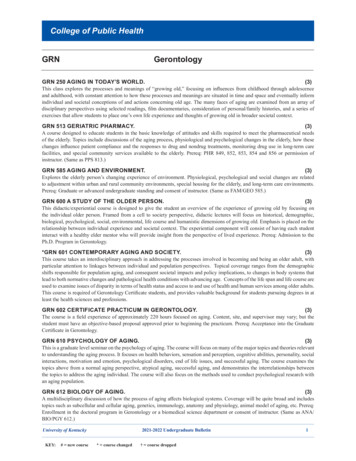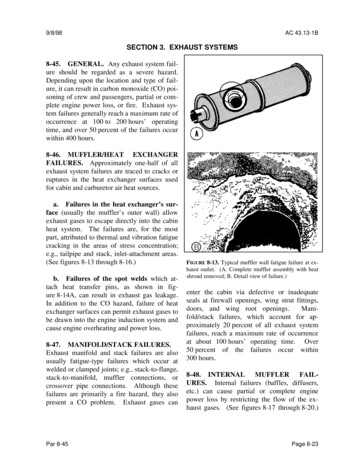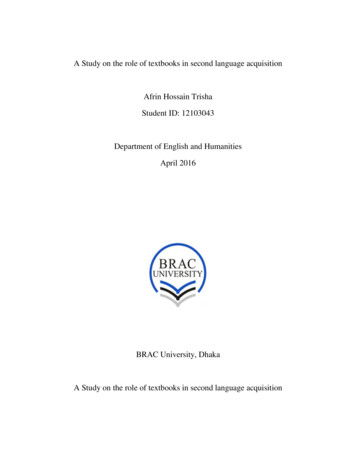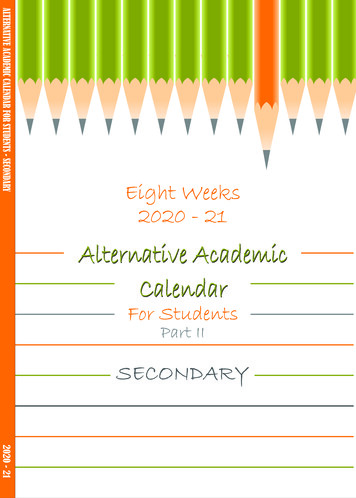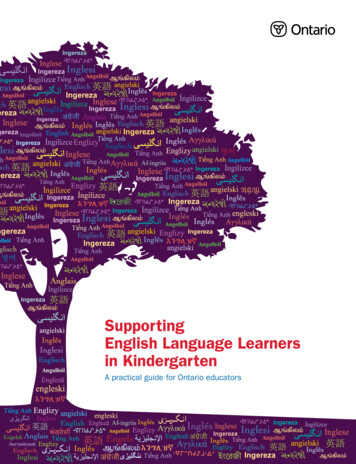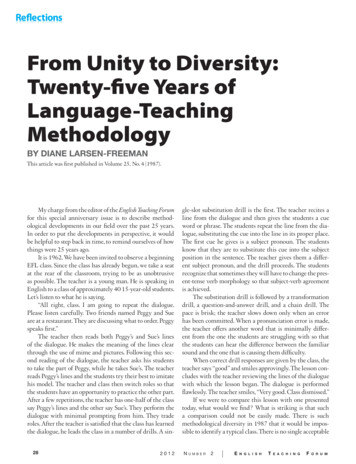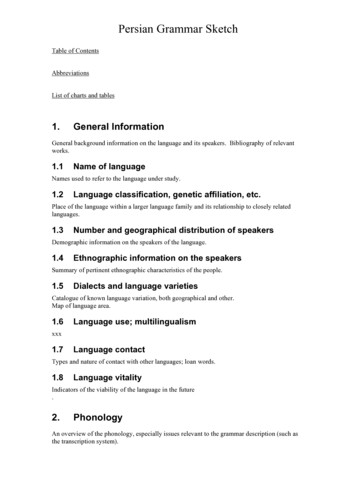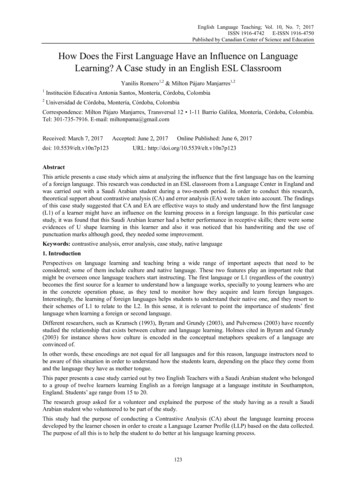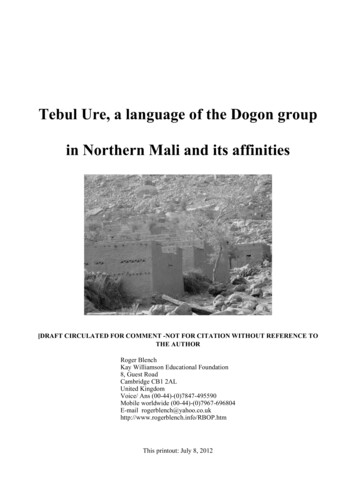
Transcription
Tebul Ure, a language of the Dogon groupin Northern Mali and its affinities[DRAFT CIRCULATED FOR COMMENT -NOT FOR CITATION WITHOUT REFERENCE TOTHE AUTHORRoger BlenchKay Williamson Educational Foundation8, Guest RoadCambridge CB1 2ALUnited KingdomVoice/ Ans (00-44)-(0)7847-495590Mobile worldwide (00-44)-(0)7967-696804E-mail /RBOP.htmThis printout: July 8, 2012
R.M. Blench Tebul Ure Wordlist Circulated for commentTABLE OF CONTENTS1. Introduction.22. Location, history and sociolinguistic situation .22.1 Nomenclature .22.2 Location and settlements.22.3 Language status.32.4 Tebul Ure culture and history .32.5 The classification of Tebul Ure .33. Phonology .33.1 Vowels .33.2 Consonants .43.3 Tones .44. Morphology .44.1 Nouns.45. Tebul Ure wordlist .5TABLESi
R.M. Blench Tebul Ure Wordlist Circulated for comment1. IntroductionThis is an annotated wordlist of the Tebul Ure language, part of the Dogon group, spoken in northern Mali.The wordlist was collected from a group of villagers in Uluban from the 28th of February to the 4th of March2005. The wordlist was collected as a ‘one-shot’ exercise and the transcription must therefore be regarded aspreliminary. This analysis was prepared by Roger Blench, who added the comparative observations1. Thisdocument is being circulated to scholars for comment.2. Location, history and sociolinguistic situation2.1 NomenclatureThe Tebul Ure language is spoken by people who call themselves Tebul U. This appears to be the samelanguage referred to in previous documents as Oru yille and Tew tegu (Calame-Griaule 1956:67). However,the settlement data is highly inaccurate so there are some uncertainties in identifying this population. Theterm ‘Oru Yille’, first used by (Calame-Griaule 1956:67) and subsequently repeated in the literature, isentirely erroneous. It appears to mean ‘two words’ in the Tebul Ure language, although no-one could explainhow this error came about.2.2 Location and settlementsCalame-Griaule (1956:67) says,Ce dialecte (appelé tew tegu en dyamsay et bede so en Toro) est parlé dans les villages de Bamba-duHaut (ceux de Bamba-du-Bas parlent le dyamsay bama tegu).Hochstetler et al. (2004) say ‘Oru yille is spoken in three tiny villages of Bamba du Haut. In addition to thexenonyms mentioned in Calame-Griaule (1956), Yanda-dom speakers call it “Tebl.”’ They give thepopulation from the 1987 census as 400. This seems surprisingly inaccurate; the Tebul U live in twentyvillages plus the recently-founded Dasalam [ Dar es Salaam]. The villages are mostly in the hill areas aboveBamba and are often no more than hamlets. There are probably 3-4000 speakers. Table 1 shows the villagesrecorded by the survey and the locations of three that are listed in the 1987 census. The villages are subclassified as follows;Table 1. Tebul U villagesGroupWardsTebul Tembe εndε gandoZan SεgεZan . :353:06:55The author is grateful to Eric Huysecom and the Swiss Ethno-archaeological project for providing funding for this survey.2
R.M. Blench Tebul Ure Wordlist Circulated for commentTable 1. Tebul U villagesSããraUlubanSããra DiineSããra PɔnduBamba TendeɔnkandaUlu kandaSεŋεDotaÄaTabaŋgɔ2.3 Language statusThe Tebul Ure language is presently being transmitted to the children. The second language of Tebul Urespeakers is Jamsay Tegu and many also know Yanda. Fulfulde, a dominant language in the zone, is not verywell known and there is a limited amount of French spoken, usually by migrant workers or students. Inaddition to the spoken language, a sign language exists in Uluban and related hamlets, which is used tocommunicate with a small number of deaf individuals. Almost all the inhabitants seem to have some fluencyin this sign language and videos were made of a number of narratives with ‘translation’ into Tebul Ure andFrench.2.4 Tebul U culture and historyNothing is known of Tebul U history, but today all villages are strongly Islamised.2.5 The classification of Tebul UreCalame-Griaule (1956:67) says,il ne s'agit nullement d'un sous-dialect du dyamsay, mais d'un dialecte très particulier qui n'ad'analogie qu'avec celui de Yanda. Il est parlé par environ 2.000 Dogon qui doivent employer ledyamsay pour se faire comprendre de leurs congénères.Calame-Griaule’s observation appears to be quite false. Yanda is the closest relative of Tebul Ure as thecomparisons in the data table show. Despite the cognacy of many items, the degree of erosion in manywords would make intercomprehension impossible and these are undoubtedly separate languages.3. PhonologyThe phonology of Tebul Ure is based on rapid observations and should therefore be regarded as tentative atthis stage.3.1 VowelsTebul Ure probably has seven phonemic ɔaOpenTebul Ure permits all vowels to be long or short and all short vowels can be nasalised. Examples ofnasalised long vowels are not so far recorded, but certainly exist in other Dogon lects.3
R.M. Blench Tebul Ure Wordlist Circulated for commentTebul Ure and other Dogon languages permit sequences of tone-bearing vowels without any consonants.These can be in contrast with sequences of vowel plus semi-vowel.3.2 ConsonantsTebul Ure consonants are as eApproximantLateral ApproximantAlveolarp bmtdnrs zAlveopalatalPalatalɲ[ʃ] [ ʒ]VelarLabialvelark gŋɣʧ ʤyGlottalhwlThere appears to be certain amount of allophonic or free variation between voiced and voiceless alveolarsand velars especially in medials. Thus a single elicitation session two speakers may produce the same wordwith k/g/, t/d. The same is true of the palatal forms of alveolar fricatives; these seem to be in free variationwith non-palatal forms. [ʃ] and [ʒ] are may not be distinct phonemes and /s/ and /S/ can be produced inparallel especially in initial position, perhaps reflecting perceptions of sentence context. However, in somewords, /S/ can be strongly palatalised, possibly a remnant of a lost syllable.3.3 TonesTebul Ure has two tones, High and Low, and few glides. For example;έŋgyέroselleɛ̀ŋgyɛ̀chicken4. Morphology4.1 NounsPlurals of nouns in Tebul Ure are typically formed by the suffix –mbɔ. This can typically assimilate to thestem in a variety of ways. Thus;cowgoatsheeppighorsena pl. nambɔine pl. inbɔpεde pl. pεdumbɔtole pl. tolmbosome pl. sombomaredonkeydogcatsomeya pl. someyambozamdule pl. zamdulumboŋgyε pl. ŋgyεmbɔbalma pl. balmabɔTebul Ure also has some irregular plurals;4
R.M. Blench Tebul Ure Wordlist Circulated for commenthuman beingaxe smallknifeɲε pl. numbafusegye pl. sepolgo pl. poleMany nouns, such as body parts, have no plurals. It is notable that the nearest relative of Tebul Ure, Yanda,has a quite different plural suffix.5. Tebul Ure wordlistThe wordlist was elicited via French and Fulfulde. This is not entirely satisfactory as pervasive multilingualism among the Dogon means that speakers could well be influenced by the phonology or lexis of thesecond language. The most likely uncertainties in transcription are vowel length, nasalisation versussyllable-final nasals and the distinction between /e/ and /ε/ and /o/ and omseed/stone/pipcharcoaldustashesmud, ningrainy seasondry echarbonpoussièrecendresboue, ageéclairsaison des pluiessaison lunesoleilétoileventcieldieuTebul UretimakuladininumayεkɔbogodooywaCommentarycf. Teŋu Kan timεcf. Yanda kula? cf. Yanda dilucf. Tɔrɔ Sɔɔ kobucf. Jamsay dudocf. Yanda òáyεjεmekɔŋguduεfɔndɔelekinunarabɔŋ edεndεswa piligɔudugutɔndoidaɔŋgoamba5cf. Yanda écf. Yanda jεmnεcf. Yanda dwẽcf. Yanda pɔndɔcf. Yanda eεl
R.M. Blench Tebul Ure Wordlist Circulated for commentEnglishworldgroundriverstreampond, terstone sheltergranarywellroad, pathpathvillagepublic placehuman ther's brothermother's sisterolder brotheryounger brothersistersondaughterold manold hémaisonchambremurtoitabri, hangarhangar en pierregrenierpuitsroute, mariépouseco-épousepèremèrefrère de la pèresoeur de la mèregrand-frèrepetit-frèresoeurfilsfillevieil hommevieille bul Ureadunɔginagondokoygataɣaandasukɔŋgoanda samsoyuwulgoεbεulodεbugɔulo kulugɔdεmbatogogwayabaɔdubasogodambaɲε pl. �dεdugetibεzεmbε, irεεdugumaysansanezεgambɔ6Commentary
R.M. Blench Tebul Ure Wordlist Circulated for gerhorntaileggwingfeatheranthillhole, pithole in h stipationjoint plumetermitière/fourmilièretroutrou dans arbrepoisonfardeau, chargebois de chosepaysmaladiearthriteroussoleTebul UreCommentarynùátin urekiladulɔtaletaÄarataÄara kula‘wing ɔdɔrɔbεra zimgokûwɔ́lsunɔ zimgoambekinε bɔmbɔnɔndɔbεra maygesuredegemɔgɔnεmε7also ‘world’. F.
R.M. Blench Tebul Ure Wordlist Circulated for itfistarmhandelbowfingerlegfootthighkneenailbreast l Urekunduvariolebalεn kɔndɔdiarrhée, écoulement du salgoventregoitrefièvregudu ɔmgɔfuroncleplaiebarmacicatricekara suŋgocervellebɔndutêtekugɔ, daraoeilgirevisagegire ekàrápoingmakumubrasnùmámainnùmá kεndεcoudenùmá tɔdɔŋdoigtnùmá yεjambelapiedla inclitorispeaugudugooskinacôteveleveinegyεŋge uth-water’
R.M. Blench Tebul Ure Wordlist Circulated for commentEnglishbone alfoxwart-hogantelope Iantelope IIantelope IIIduikerporcupinevervet monkeypatas lopeantilopeantilopeduikerporc-épicsingesinge tedaman des rocherslièvremoutonTebul kula‘chin-hair’kεndεkεndε dugadεndayεpudubadugɔdugɔnamaanda ga εsε gambɔprobably incorrectɔgɔ ɲuŋɔna pl. nambɔnan zaŋgεine pl. inbɔin zaŋgεpεde pl. pεdumbɔpεde zaŋgεtole pl. tolmbosome pl. sombosomeyapl.someyambozamdulepl.zamdulumboŋgyε pl. ŋgyεmbɔbalma pl. balmabɔdεmyawilyεduyεrataanda balmɔvilεciniyaomo bane‘monkey-red’bilεɔŋgɔ pεdεsanagandakɔndɔzomo9identification doubtfulidentification doubtful
R.M. Blench Tebul Ure Wordlist Circulated for commentEnglishbush ameleonagama lizardgeckomonitor lizardtoadfrogtortoisesnakecobrapythonsnake sp. Isnake sp. Isnake sp. Isnake sp. Isnake sp. ulturecattle-egrethawkowlbush-fowlswallowpied ying antgrasshoppermantisFrançaisrat de ssettecrocodile, caïmancaméléonmargouillatgecko, salamandreiguane, rpionpapillonlibellulemoustiquearaignée de la rdtermite/fourmi blanchefourmi volantesauterellemante religieuseTebul �gɔɔŋgɔ dεaŋguŋ gurunɔndonɔndo zumɔkɔkɔdεaŋsarakɔndum daanεabazumɔin kobra kaduideadeεŋgyaεŋgya anataga yεrikagadapεrεgεrεbandεŋtebe dubaamba pipirtebeduɲaanda εŋgyεcigibeyakaŋamɔmpopipirsanekubasoysɔm bεlamamegεnεkarankaidumbu uledundomεlεpεrεgεrε εsa kindε10Commentary
R.M. Blench Tebul Ure Wordlist Circulated for eerhandlepeelingssicklegrass sicklefruit harvesterfirewood knifeharvesting knifecutlassironaxe bigaxe smalladzesowing hoehoe Ihoe IIhoe weezersbellowscooling aceletmortarpestlepotpot Ipot IIpot IIIpot IVhead-padbasketFrançaismouche de feuver de terrehuilegraisseselsaucenourriture/tobièremanche d’outilfaucillefaucillehameçon de fruitcouteau de bois de feucouteau de moissonmachetteferhache grandehache petiteherminettesemeurhoue Ihoue IIhoue IIIcouteaucouteau pour nattesrasoirenclumemarteaupincesalèneburintire l’épinesouffletbol ierbaguebraceletmortierpilonpotcanari Icanari IIcanari IIIcanari IVcoussinetpanierTebul �kwɔndɔkudugɔkwɔdɔkɔrɔkɔrɔ gayiŋgoyεpεm kegedoogɔndupɔlgaŋgo -no pl.indεgulaa no pl.segye pl. sesɔgɔdaba kɔrɔanawa dabazεgεyεpolgo pl. polefor splitting logswomen’s hoe, straight-handledmen’s hoe, curved handlesmall hoesilbe no �gεdɔŋgɔtyavery largesmall water-potsmall potlarge-mouth pot11
R.M. Blench Tebul Ure Wordlist Circulated for commentEnglishwinnowing steplintelbedfenceforked l resuŋgotuŋgurgɔkaŋgakaŋga papakaŋga hiveMusicdrum Idrum our-sabliertambourdrum IIItambourbɔn yarbadrum IVhollow logskoraluteflutewhistlerattle Irattle IIgourd shakertambourblocs de boiskoraluthflûte traversièresifflethochet calebassehochetbɔŋgokɔrɔtransverse horn Itransverse horn IIiron belliron slit veneightninecornecorneclochette de ferclochette de fer à fentesistre des epthuitneuftiŋgu ladde luŋgusɔgɔ koropɔŋgolugaCommentarykɔmbɔ kyεmgɔ ‘bow and arrow’‘container’forked stick for holding together thornenclosuresdoubtfuldebɔn sodokaŋgam2-headed cylindrical drum tied at thewaist2-headed barrel drum hung fromshouldergeneric name for drum ensemblejiŋgurkeremagaa εmgpsagarahalf-calabash with cowries attached toleather strings on the outside, �dεyinumyikuleyisɔyigagarayigagaraba12
R.M. Blench Tebul Ure Wordlist Circulated for ortyfiftysixtyseventyeightyninetyone hundredwhiteblackredgreenyellowother e-vingt-dixcentblancnoirrougevertjauneautres sloin/lointainbeaulaid, vilainchaudfroid, fraisfortfaiblemûrTebul Ureyipεlpεnε tursagapεnε lesagapεnε gasɔsuŋgusuŋgu yi pεlsuŋgu pε �mukiyεlupaŋgapaŋga sɔndɔɔilε13Commentary
R.M. Blench Tebul Ure Wordlist Circulated for dd toagreeallowannounceanswerapply (ointment)arriveask forbe bentbe bornbeatbeginbiteblow (mouth)blow (wind)blow y humanbury objectbuycallcare forcarrycarry on backcarry on headchewchoosechop scry raccompagnerajouterêtre d'accordlaisser naîtrebattrecommencermordresouffler (la bouche)souffler (vent) Isouffler (vent) nstruire, porterporter sur le dosporter sur la têtemâcherchoisirabattretrancherfermerse riercouperdanserTebul ayekete taŋukegeketege14Commentary
R.M. Blench Tebul Ure Wordlist Circulated for commentEnglishdiedigdividedodraw waterdreamdrinkdrive awaydropdry upeatenterextinguishfallfearfillfindfinishfly (v.)foldfollowforbidforgeforgetgathergivegive birthgogo downgo outgo ltjumpkillknowlacklaughlearnleavelendlicklielift onto usserlaisser mplirtrouverterminervoler lerbroyergrandir, échermentirsouleverallumeraimerTebul ykilimεdedinbikanu aluɲawtaanduibii15Commentary
R.M. Blench Tebul Ure Wordlist Circulated for commentEnglishlimplistenlook forlosemake a mistakemarrymeasuremilkmixnurseopenpaypeelpick uppierceplasterplaypoundpourpullpushputput arpenshaveshootshowsingsit downsleepsmellsmoke rperdrese refuserse souvenirréparerressemblerse reposerrevenirmonter un dresecoueraiguiserse rasertirermontrerchanters'asseoir/être assisdormirsentirfumer (tabac)éternuerronflerTebul �izigibekaatagaobugogirenigezindutabu dugo ɲaw16 F.
R.M. Blench Tebul Ure Wordlist Circulated for commentEnglishsoaksowspitstaystealstick ontostingstrollsuckswallowsweepswellswimtaketake offtalktasteteachteartear offtellthinkthrowtietouchtrembletryturn t/needwash s.t.wash selfweaveweedweepwhisperwhistlewipe (nose)writeyawnQ wordswhere?when?how?how many?why?Françaisfaire trempersemercracherrestervolercollerpiquerse nserjeternouer/attachertoucher, palpertrembleressayerse retournertordrese ttendremarchervouloir/avoir besoinlaver q.c.se lavertissersarcler/arracher les herbespleurerchuchotersifflerse ienpourquoiTebul UreCommentarytɔŋgo tɔwayoɲɔ banduɲaanzirulaygεrazaŋgumakadiyaayoru pεjεmaandugogitekɔnbemiiduŋgɔ gonlomεdekɔnbɔindigulagɔĩ aŋgaaŋgyee dugɔ17 F.
R.M. Blench Tebul Ure Wordlist Circulated for ownnorthsoutheastwestI, meyouhe, she, itwe, uswe twoall of usyouthey, themFrançaisquiquoiAutresicilàà gaucheà droiteTebul UreanmuŋgyeeCommentaryungɔmangabanda bariɲεŋε baritεnbε baridugo baridubaritengule baritunbemgo baripilemgo barimiuɔmíílèípùbibunordsudestouestje, moitoilui, ellenousnous tousvousilsPlantsEnglishFrançais2Tebul UremaniocbalankunSweet potato3patate doucebalankun bumbaWild yamigname de brousseCassavacerealsCommentaryεnεSorghum4grand milεmbεvarieties: εmbε dumbɔ, εmbεgado, dijire, pεlkuma, dimbilmale. εmbε girima kãyBulrush millet5petit milyɔvarieties: yudo, yudobere, yujεFonio6foniopɔ̃Maize*7maissa nembeRice*8rizáráCowpea9nyebenimε2(Manihot esculenta)(Ipomoea batatas)4(Sorghum bicolor)5(Pennisetum spp.)6(Digitaria exilis)7(Zea mays)8(Oryza sativa/ glaberrima)9(Vigna unguiculata)318
R.M. Blench Tebul Ure Wordlist Circulated for commentEnglishFrançais10Tebul UreCommentaryBambara groundnutpois de terreεgε gεmεGroundnut11arachideεgε banεTiger-nut12souche à mangergɔPerfume sedgesouche à parfumgɔ anaGarden 15oseilleέŋgyέKenaf16kenafkulereBirdseye llay Fr.Tomato19tomatetamatu Fr.Melon (other)20courgezɔgɔEdible squash21potironSesame22sesamPawpaw*23‘red groundnut’pɔlepapay Fr.Gourd rdindeGourd (spherical)25calebasse rondeundu kundugɔgourd spoonlouchenjir bɔŋɔother gourds Iautres calebassesgogofor watering gardensother gourds IIautres calebassesgogo sabogofor drinking water10(Vigna subterranea)(Arachis hypogaea)12(Cyperus esculentus)13(Solanum melongena)14(Abelmoschus esculentus)15(Hibiscus sabdariffa)16(Hibiscus cannabinus)17(Capsicum annuum)18(Allium sativum)19(Lycopersicon esculentum)20(Cucumis spp)21(Cucurbita pepo)22(Sesamum indicum)23(Carica papaya)24(Lagenaria siceraria)25(Cucurbita maxima)1119
R.M. Blench Tebul Ure Wordlist Circulated for commentEnglishFrançaisTebul iershimDum palmdoumierBaobab27arbre de painɔraShea tree28kariténuŋgɔF. karehiLocust tree29néréyulgoF. narehiLocust fruitLocust-bean cakesF. njelokiGuiera senegalensisAnogeissus leiocarpuskojoliSecuridaca longepedunculatageleje, alalePiliostigma reticulatumF. barkiCassia toraF. uloAcacia albidabalanzanF. ceekiBalanites aegyptiacaTamarind30tamarinierumbuleetree sp. Iarbre sp. Ishidi belatree sp. Iarbre sp. Ijεŋatree sp. Iarbre sp. Ibalεtree sp. Iarbre sp. Inεnεmεtree sp. Iarbre sp. Iugulεmgotree sp. Iarbre sp. Ipopolomtree sp. Iarbre sp. Iagultree sp. Iarbre sp. Iɔrtree sp. Iarbre sp. IkuraSodom apple3126(Borassus aethiopum)(Adansonia digitata)28(Vitellaria paradoxa)29(Parkia biglobosa)30(Tamarindus indica)31(Calotropis procera)2720
R.M. Blench Tebul Ure Wordlist Circulated for commentEnglishFrançaisTebul Uretree sp. Iarbre sp. Ikambetree sp. Iarbre sp. Ikuniyatree sp. Iarbre sp. Ipɔƒɔtree sp. Iarbre sp. Ipupumgɔneemneemgɔjitree sp. Iarbre sp. Ikumbugɔwater lettuceŋge silbeMariscus spp.sar kɔmbɔCommentaryPistia stratiotesReferencesBendor-Samuel, J., E. J. Olsen, and A. R. White, 1989. Dogon. In: Bendor-Samuel, J. (ed). The NigerCongo Languages—A classification and description of Africa’s largest language family. Lanham,Maryland: University Press of America. 169–177.Bertho, J. 1953. La place des dialectes dogon de la falaise de Bandiagara parmi les autres groupeslinguistiques de la zone soudanaise. Bulletin de l’IFAN 15: 405-41.Calame-Griaule, G. 1956. Les Dialectes Dogon. Africa, 26(1):62–72.Calame-Griaule, Geneviève. 1968. Dictionnaire Dogon—dialecte tɔrɔ—Langue et Civilisation. Langueset Littératures de L'Afrique Noire. IV. Paris: Klincksieck.DNAFLA/DRLP. 1981. Enquêtes dialectologiques Dogon relatives au choix du dialecte de référencepour l’alphabétisation fonctionnelle. miméo. Bamako: DNAFLA.Hochstetler, J. Lee, Durieux, J.A. & E.I.K. Durieux-Boon 2004. Sociolinguistic Survey of the DogonLanguage Area. SIL International. Available at: ewcomer, Betsy. 2000. Exploring dialect difference of Dogon speakers in Mali. Senior thesis. Bryn Mawr,PA: Bryn Mawr College. pp. 53 four wordlists maps.Plungian, Vladimir A. et Issiaka Tembine, 1994. Vers une description sociolinguistique du pays Dogon:attitudes linguistiques et problèmes de standardisation. In Dum94, pp. 163–195.Togo, Th. 1984. Quelques chants initiatiques dogon chantés en tombò sò à l’occasion de la circoncision,Mémoire de fin d’études de l’Ecole Normale Superieure. Bamako: E.N.Sup.Williamson, Kay & R.M. Blench 2000. Niger-Congo. In: African languages: an introduction. B. Heine & D.Nurse eds. 11-42. Cambridge: Cambridge University Press.Websiteshttp://www-personal.umich.edu/ jheath/21
term 'Oru Yille', first used by (Calame-Griaule 1956:67) and subsequently repeated in the literature, is . addition to the spoken language, a sign language exists in Uluban and related hamlets, which is used to . Thus a single elicitation session two speakers may produce the same word with k/g/, t/d. The same is true of the palatal .
